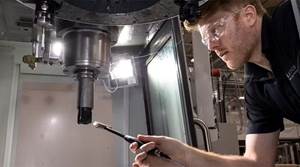California Specialty Parts Machinist Has No Room For Error
Much of the current equipment at this plant is German and Swiss machinery, including two Deckel mills (FP4 and FP3), a Bridgeport mill and Schaublin (10-inch) and HES (20-inch) lathes, among other various saws. In order to keep the parts as accurate as possible, the controls and DROs that are used need to be accurate and reliable.
Share





Group 5 Engineering Inc. (El Segundo, California) specializes in machining high-end parts for two very different worlds: One is for the commercial aviation industry, and the other is for specialty custom hardware used in fine homes. Many aviation-type parts are machined there, including rudder posts, throttles and yolk shakers (stall indicators) for big aircraft; cargo door latches of various sizes; dampers; and various hydraulic test fixtures. The custom home hardware ranges from solid stainless steel fancy drawer pulls and huge front door handles with solid backing plates to special bronze grates for pools and showers.
All of this specialty work is being coordinated by company owner Rich Ushler. And he has no room for error.
"Some of the parts I do are worth $75,000, so if I make a mistake, I'd have to mortgage my house," he says. Mr. Ushler is no stranger to the machining world, as he has been involved in it for about 30 years, and his small shop is now known in this California area as a place for expert part machining.
The high accuracy of Group 5 Engineering's work is of utmost importance, and the company is called upon again and again because of this expertise . . . as well as because of the reliability and accuracy of the equipment. Much of the current equipment at Group 5 Engineering is German and Swiss machinery, including two Deckel mills (FP4 and FP3), a Bridgeport mill and Schaublin (10-inch) and HES (20-inch) lathes, among other various saws.
In order to keep the parts as accurate as possible, the controls and DROs that are used need to be accurate and reliable. The shop found what it needed in Heidenhain (U.S. subsidiary in Schaumburg, Illinois).
"When you are dealing with such expensive parts, it is imperative to be certain where you are," explains Mr. Ushler, "and I am confident about my position with the Heidenhain feedback." Mr. Ushler's affinity for Heidenhain began almost two decades ago when he purchased a Bridgeport machine with a Heidenhain control already on it. "It was accurate, reliable and easy to use even then," continues Mr. Ushler.
Since then, when Mr. Ushler decides he needs to automate or increase the accuracy of his manual equipment, he systematically turns to Heidenhain, often to its digital readout (DRO) systems (or "RETROKITs" for both mills and lathes).
"They work, I understand them, and they are reliable," he says. The Heidenhain RETROKITs typically consist of a two-axis DRO and two sealed glass optical linear scales complete with armor shielded cables, custom designed brackets and arm/tray assembly for easy installation.
They are offered in various sizes. The optical linear scales vary per application, but they typically:
- have a grating period of 20 microns (50 pulses per millimeter),
- have an accuracy grade of ±10 microns,
- have distance-coded reference marks and
- are rated IP 53 (ideal for shop floor environments).
At Group 5 Engineering, Mr. Ushler has one mill that is at least 20 years old that had, at that time, been retrofitted with Heidenhain's VRZ 710 readout and its LS 603 glass optical linear scale. "The scale has performed flawlessly and is still working," says Mr. Ushler.
Mr. Ushler continues to rely on Heidenhain feedback systems for their accuracy and reliability. His latest lathe retrofit consists of Heidenhain's ND 730 DRO and its LS 603 linear scales. "If these systems save me from making a single mistake, they've paid for themselves," says Mr. Ushler, "and they do."
Also, much to Mr. Ushler's happiness, his Deckel machines already came equipped with Heidenhain.
"My Schaublin lathe is my only large machine that is manual," states Mr. Ushler, "and I do plan a DRO system purchase from Heidenhain in the near future to increase its accuracy."
Related Content
Orthopedic Event Discusses Manufacturing Strategies
At the seminar, representatives from multiple companies discussed strategies for making orthopedic devices accurately and efficiently.
Read MoreHow to Mitigate Chatter to Boost Machining Rates
There are usually better solutions to chatter than just reducing the feed rate. Through vibration analysis, the chatter problem can be solved, enabling much higher metal removal rates, better quality and longer tool life.
Read MoreThe Power of Practical Demonstrations and Projects
Practical work has served Bridgerland Technical College both in preparing its current students for manufacturing jobs and in appealing to new generations of potential machinists.
Read More2 Secondary Coordinate Systems You Should Know
Coordinate systems tell a CNC machine where to position the cutting tool during the program’s execution for any purpose that requires the cutting tool to move.
Read MoreRead Next
AMRs Are Moving Into Manufacturing: 4 Considerations for Implementation
AMRs can provide a flexible, easy-to-use automation platform so long as manufacturers choose a suitable task and prepare their facilities.
Read MoreMachine Shop MBA
Making Chips and 91ÊÓƵÍøÕ¾ÎÛ are teaming up for a new podcast series called Machine Shop MBA—designed to help manufacturers measure their success against the industry’s best. Through the lens of the Top Shops benchmarking program, the series explores the KPIs that set high-performing shops apart, from machine utilization and first-pass yield to employee engagement and revenue per employee.
Read MoreLast Chance! 2025 Top Shops Benchmarking Survey Still Open Through April 30
Don’t miss out! 91ÊÓƵÍøÕ¾ÎÛ's Top Shops Benchmarking Survey is still open — but not for long. This is your last chance to a receive free, customized benchmarking report that includes actionable feedback across several shopfloor and business metrics.
Read More






















